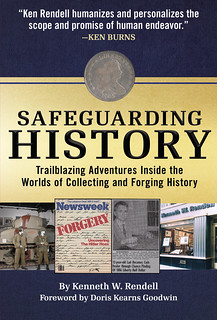
PREV ARTICLE
NEXT ARTICLE
FULL ISSUE
PREV FULL ISSUE
BOOK REVIEW: SAFEGUARDING HISTORYDennis Tucker of Whitman Publishing writes:
"E-Sylum readers might be interested to know that Ken Rendell's memoir, Safeguarding History, has been reviewed by Bruce E. McKinney in Thank you. Here's an excerpt - see the complete article online for more. -Editor
When kids find their imaginations soaring about old books and paper, they inevitably daydream about discovering gems and subsequently share their prizes with luminaries, collectors and institutions. In the human imagination, possibilities live. Children have long been drawn into the magic of discovery and some lucky few grow up to spend their lives in the embrace of collecting wanderlust. Kenneth Rendell has lived that life. While many are drawn, few have both the retentive memory and comparative logic necessary to play at the highest levels. Mr. Rendell has both as well as boundless self-confidence and an engaging style. Taken together, you have the makings of an exceptional dealer who becomes the scholar-expert. His story will quicken the hearts of those who hope to follow his path. He's fundamentally a mathematician and early on applied his skills to estimate rarity of coins while relying on the established standards for quality. Understanding that coins were unevenly distributed and knowing the total number of specific versions minted, he tried to locate their repositories and found ways to look at them with the goal to buy the best examples. It sounds simple and straightforward, but few others tried that approach in the 1950s and in his teens he earned enough money to set himself up as a professional coin dealer. Soon after, using his deep intelligence, he began to look for opportunities beyond coins, stamps and books that had known, or probable quantities printed or minted, he then began to look for collectibles whose values were scalable by importance of their content. For that he shifted to manuscript material. To deal stamps, coins, and books there were three variables; number of copies printed, copies or examples known, their conditions, and special factors such as bookplates or inscriptions. For manuscript material there was a kaleidoscope of other variables, by who and to, its timing, priority and subject as well as its condition. For stamps, coins and books they have long had well-documented histories. They are checkers while manuscripts are chess. As Mr. Rendell entered the manuscript field in the 1960s, other dealers, collectors, collecting institutions and counterfeiters were joining the fray too. Rising prices appealed to everyone. His approach about manuscripts evolved into monetizing the significance of content after such documents had a long sleepy period in the market. He, and his research team, sought to contextualize documents and caught the wave of rising interest.
It seems odd today to think that content was ever not deeply plumbed because content seems to have long been the basis for current dealer and auction pricing, but it turns out – serious attention to content primarily dates from the 1960s. Age and names had been emphasized and continue to matter. But going forward, pricing would rocket as content and priority brought many new collectors into the field. Mr. Rendell's fingerprints would be all over the trend. In his chapter 9:
To read the complete article, see:
To read the earlier E-Sylum article, see:
Wayne Homren, Editor The Numismatic Bibliomania Society is a non-profit organization promoting numismatic literature. See our web site at coinbooks.org. To submit items for publication in The E-Sylum, write to the Editor at this address: whomren@gmail.com To subscribe go to: https://my.binhost.com/lists/listinfo/esylum All Rights Reserved. NBS Home Page Contact the NBS webmaster 
|


